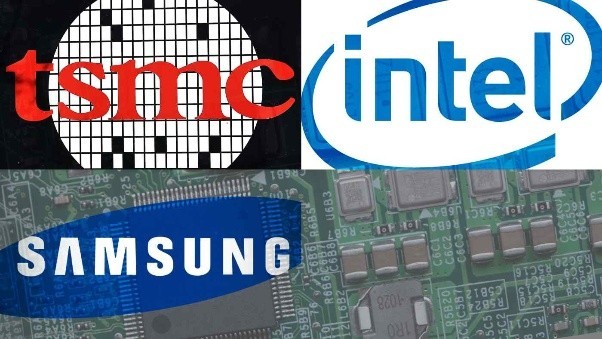Samsung, Intel, TSMC, which one is stronger in advanced packaging?

(The picture comes from the Internet)
Samsung officially announced mass production of 3-nanometer chips at the end of June, taking the lead in the competition with TSMC and Intel's advanced manufacturing process. Recently, the three manufacturers' battle situation in advanced packaging has also ushered in the latest progress. According to foreign media sources, Samsung established a semiconductor packaging working group in mid-June to strengthen cooperation with major customers.
In the context of the increasing performance requirements in the current semiconductor field and the gradual failure of Moore's Law, advanced packaging has become a new focus. It is reported that the chiplet solution that integrates multiple chips heterogeneously through advanced packaging technology, or splits traditional large chips into multiple small chips, and integrates them through advanced packaging technology can greatly enhance functions and reduce costs. As a result, Samsung, TSMC, and Intel seem to be bound to gain advanced packaging technology.
1► Speeding up and coding advanced packaging, Samsung is struggling to catch up
According to foreign media reports, Samsung's Device Solutions (DS) division has established a semiconductor packaging working group directly under co-CEO Kyung Kye-hyun in mid-June, with the aim of strengthening its relationship with major foundry customers. Cooperation in the field of packaging. According to the news, this group has assembled test and system packaging engineers from Samsung DS Division, researchers from the Semiconductor R&D Center, and personnel from the memory and foundry departments, and is expected to come up with more advanced packaging solutions.
In terms of advanced packaging technology, Samsung launched the 2.5D packaging technology I-Cube earlier, and in August 2020 announced the launch of a new generation of 3D packaging technology - X-Cube, which can combine different chips based on TSV through silicon technology. Stacking, currently used in 7nm and 5nm processes. In recent years, Samsung has accelerated its efforts in advanced packaging. At the end of 2021, Samsung once again announced that it has developed the latest 2.5D packaging solution H-Cube, and said that it is also developing the latest "3.5D packaging" technology. However, comparing the packaging technology and commercial application of TSMC and Intel, Samsung is still lagging behind.
2►Four-point development route guidance Intel is unique
Intel is unique in advanced packaging technology. As early as the end of 2018, Intel launched the industry's first 3D logic chip packaging technology - Foveros 3D, which can stack logic chips of different processes on logic chips.
At the Intel Accelerated Technology Briefing held by Intel in 2021, Intel adopted a new naming system, namely Intel 7 (previously called 10nm Enhanced SuperFin), Intel 4 (previously called Intel 7nm), Intel 3 and Intel 20A.
Subsequently announced, and Intel's four-point development route on packaging technology, namely EMIB technology, Foveros technology, Foveros Omni technology and Foveros Direct technology.
Among them, EMIB will be the first technology to adopt the 2.5D embedded bridge solution. At the recent Intel On Industry Innovation Summit, Intel's fourth-generation Xeon processor Sapphire Rapids using Intel 7 process technology was unveiled and became the first Products using EMIB packaging technology; Foveros will use wafer-level packaging technology to provide the first 3D stacking solution in history; Foveros Omni will make die-to-die interconnection and modular design through high-performance 3D stacking technology More flexible; Foveros Direct enables the transition from copper to copper bonding, as well as low resistance interconnects.
3► The best products are excellent, TSMC takes the lead
TSMC has been deploying 2.5D and 3D advanced packaging technologies for more than 10 years. In recent years, its update and iteration speed has accelerated, and the constantly launched fist products have attracted the attention of the industry. Overall, TSMC has integrated 2.5D and 3D advanced packaging related technologies into a "3DFabric" platform, which allows customers to choose freely. The front-end technology includes a 3D integrated chip system (SoIC InFO-3D), and the back-end assembly test Related technologies include 2D/2.5D integrated fan-out (InFO) and 2.5D CoWoS series family.
Recently, TSMC held the 2022 TSMC Technology Symposium in Santa Clara, California, and announced two major breakthroughs in the 3D Fabric platform. -SoICTM)-based central processing unit, which uses Chip-on-Wafer (CoW) technology to stack SRAM as a L3 cache; the second is to use Wafer-on-Wafer (WoW) technology to stack on Breakthrough intelligent processing unit on top of deep trench capacitor chip.
Support for N5 technology is planned for 2023, as CoW and WoW N7 chips are already in production, TSMC said. In addition, in order to meet customers' needs for system integration chips and other TSMC 3D Fabric system integration services, the company will build the world's first fully automated 3D IC advanced packaging factory in Zhunan, which is expected to start production in the second half of this year.
In addition, it is worth mentioning that TSMC has also built a 3D IC R&D center in Tsukuba, Japan, which was opened on June 24 this year.
Parts of materials of this site come from the internet, please contact if there is infringement





